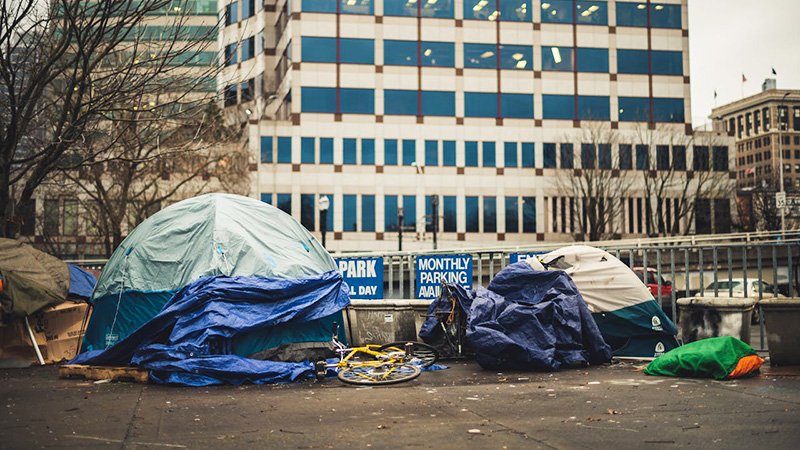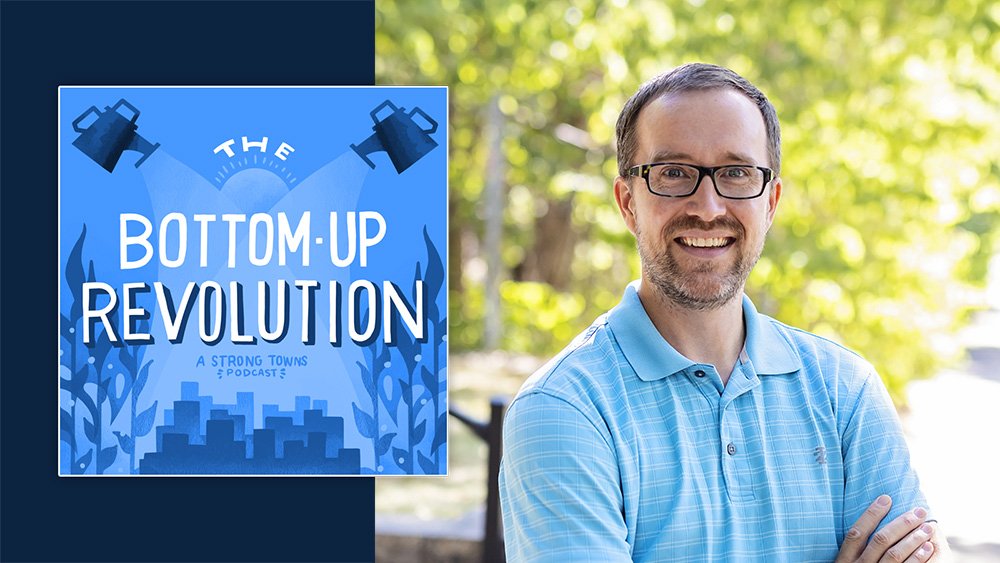You Can’t Arrest a Housing Shortage: Why Anti-Homelessness Laws Don’t Work
I used to live in the “Meanest City in America.”
That label is what the National Coalition for the Homeless bestowed on Sarasota, Florida, back in 2006. This was in response to a perceived culture of aggressive criminalization of those living on the city’s streets, including a citywide ban on camping on public property. In 2011, Sarasota drew national headlines for removing all of the benches from its central downtown park in an explicit effort to drive away homeless people who congregated there. (It worked, sort of; it also, predictably, drove away everyone else.) In 2012, a man was arrested for “theft of utilities” after charging his phone from an outlet in a public picnic shelter. Police drew scrutiny after internal emails suggested a culture of “bum hunting.”
Did this “meanness” work as a strategy? Emphatically, no.
After growing to a rate of six times the national average by 2014, during the period of “meanness” as official policy, Sarasota’s chronically homeless population has decreased by about half, largely due to concerted efforts by a host of service providers and nonprofits. There are still outdoor makeshift encampments. The places where homeless individuals congregate move around, often because of dispersal by police, but they haven’t gone away.
Even setting aside the question of whether being “mean” to people living on the street is morally defensible, does it even work? Does it solve the problem it is intended to solve, which is (being charitable in defining the problem, as we should be) to ensure that the residents of a place are able to make use of public spaces without being threatened or harassed?
My consistent impression has been no. It basically never does. And this is only surprising if you believe that homelessness is a matter of behavior — that the problem is that people are choosing to camp out in city parks, on sidewalks or under bridges, and that they’re doing so because this behavior is somehow encouraged or insufficiently punished.
I’ve been thinking about this issue a lot since the Supreme Court issued its long-anticipated ruling in City of Grants Pass v. Gloria Johnson on June 28. The 6-3 Grants Pass decision holds that cities may enforce bans on sleeping in public places, even if there are not enough shelter beds available.
The ruling is probably the most important judicial ruling on homelessness in decades. In many ways, it's also a distraction from productively addressing homelessness. Before they can do that, people must first understand what the problem of chronic homelessness actually is.
Homelessness Is the Result of a Broken Housing System
The research is quite clear on this: Homelessness reaches epidemic levels in communities where housing is far too expensive and there is not enough of it.
Let’s unpack this a little. There are individual determinants of homelessness, and there are societal determinants of homelessness. The former are factors in someone’s life that might explain why an individual becomes unhoused. The latter are the reasons the rate of chronic homelessness varies dramatically from one city or region to another.
Individual factors (for instance, poverty) fail to predict regional differences in the prevalence of chronic homelessness at the population level, according to the book "Homeless is a Housing Problem," published in 2022 by Gregg Colburn and Clayton Aldern.
(This graph shows the extreme variation in homeless rates across the country. Source: Homeless is a Housing Problem.)
(This graph shows that rates of homelessness actually decrease in places with higher poverty rates, meaning that individual factors like poverty can’t explain homelessness on their own. Source: Homeless is a Housing Problem.)
What does predict homelessness rates much more reliably is housing unaffordability.
Because the housing market functions like a giant game of musical chairs, when housing is insufficient, the result is vicious competition — and dire outcomes for the ultimate losers of the game. In high-cost cities, even middle-class people struggle to pay rent, while poor individuals crowd into increasingly precarious situations. One missed paycheck, medical emergency, or conflict with roommates or family can mean living out of a car (a large majority of homeless people are temporarily, not chronically, homeless, and most sleep in vehicles) or on the street.
High rents also strain the safety nets of those with incomes so low or unreliable that the market will never be able to serve them. As I wrote in "Escaping the Housing Trap," when rents are so high that even middle-class, employed people struggle to pay them, “we might end up subsidizing housing for schoolteachers and firefighters” rather than efficiently using limited subsidy dollars to help the truly poor. (Teacher housing subsidies are already routine practice in California, where schools face staffing shortages.)
A city serious about reducing its rate of chronic homelessness will urgently work to legalize the production of enough housing to meet needs across the market. This means reforming zoning codes to get out of the way of development in the neighborhoods where homes are needed (which is most of them); cultivating local developers who will build modest starter homes at scale; and using local financing tools to jump-start these efforts. And, of course, there’s a need for a lot more subsidy dollars to support permanently affordable housing for very low-income individuals.
Addressing the Problem From Hell — Next Week, Not Next Decade
Yet at the same time, these market-based reforms are a long-term, systemic answer. They are not any sort of short-term answer to the problems of people living on the street.
Endemic homelessness — when your city has people living in tent encampments every night — is a problem from hell. Let’s not pretend there are any simple or truly morally satisfying answers to this problem.
Do you choose the hard cruelty of forcibly breaking up encampments full of desperate people, tearing down tents and arresting individuals who will be released into the same desperate straits a day or two later? Of often depriving them of the only possessions they have in the process, and sending them packing knowing full well that they have nowhere to go? This is the case in Grants Pass, where shelter capacity is grossly inadequate and where the only shelter is a “high-barrier shelter” that many homeless residents will find themselves unable or unwilling to use because of (for example) their gender identities or addiction problems.
Or do you choose the softer cruelty of denying the residents of a city comfortable access to and use of its public spaces? Not to mention the soft cruelty of tolerating encampments rife with concentrated social dysfunction that are unsafe, above all else, for their own residents. (In Los Angeles, about a quarter of the city’s murder victims are homeless, even though homeless individuals only make up 1% of the population.)
I can already hear the chorus of “Stop being crybabies; the fact that the unhoused make you uncomfortable isn’t a real problem.” These reactions are common and well-meaning (rooted in empathy for people who are poor and suffering), but they are misguided.
The Grants Pass case arose in the courts because of a situation in which a long-term encampment took over a public park. This isn’t an isolated situation. I have friends in Minneapolis who effectively lost access to their neighborhood park when it was in use for a large encampment. This was during the COVID pandemic when outdoor recreation was a lifeline for mental and physical health.
Public transit is another area that can be a flash point when people with few options begin to use it as a sort of mobile shelter. I took my kids, ages 2 and 4, on the light rail recently and there were large amounts of trash, passengers who smelled of urine and a couple of riders who were plainly under the influence of drugs — one of whom I watched give herself an injection. It was a deeply unpleasant experience and difficult to explain to small children. (It was also not totally the norm, to be clear: We’ve had other, much less eventful train rides together as a family.)
Solutions to this are elusive. Being “mean” is not one, though.
I understand the frustration of city officials that might cause them to celebrate the Grants Pass decision, as local politicians up and down the West Coast have, including San Francisco’s mayor and California’s governor. It’s not heartlessness. It’s the brutal calculus of weighing a status quo that is cruel in an ongoing, drip-drip-drip way against an action to alter that status quo that is cruel in an acute and visceral way.
As in so many things, I think Strong Towns thinking is valuable here: act incrementally and iteratively, with the resources available, with a bias toward action and with an understanding that the best results happen when decision-making happens at the interpersonal scale, not the impersonal or bureaucratic one.
I’ve been impressed by the tiny house village efforts that seek to create a stable and self-policing social structure among homeless residents by giving them a sense of ownership and dignity in their space. Here is a very long, worthwhile read about this model of “tent city urbanism,” and here’s a shorter summary. It’s not a utopia, but it’s an affordable way to create a markedly better version of an encampment.
Even the term “village” is part of the strategy here. People will behave differently when they are cognizant of being in the place they live.
Another thing that a strong town should do is consider the vital importance of a universal, high-quality public realm. In other words, cities should do the opposite of what Sarasota did when it removed the benches downtown. Provide ample, inviting places to gather in public. Ensure that your park system is well maintained and well used, and engage the community in creating programming for underused spaces to draw a diverse swath of your city’s residents to the space. Don’t skimp on providing public restrooms where they are needed. (This does not need to break the budget, as the experience of Medicine Hat, Alberta, shows. But in America, we tend to overthink and overcomplicate the process.)
The goal is that your public realm will be so well used and enjoyed, by rich and poor alike, that the negative externality of the minority of people suffering some personal dysfunction will be muted. Policing can be part of this strategy, but “mean” approaches that inflict extreme cruelty on a few while not improving the public realm for the many cannot solve the problem.
Arresting those sleeping on the streets, cycling them in and out of jail or levying fines they almost certainly can’t pay is not any sort of effective response to the problem. It’s not even a Band-Aid for the problem; it’s more like vaguely dabbing at an open wound with a tissue. City leaders who want to be humane and do right by their residents (both housed and unhoused) will turn their attention to a much more productive set of responses.









Daniel Herriges has been a regular contributor to Strong Towns since 2015 and is a founding member of the Strong Towns movement. He is the co-author of Escaping the Housing Trap: The Strong Towns Response to the Housing Crisis, with Charles Marohn. Daniel now works as the Policy Director at the Parking Reform Network, an organization which seeks to accelerate the reform of harmful parking policies by educating the public about these policies and serving as a connecting hub for advocates and policy makers. Daniel’s work reflects a lifelong fascination with cities and how they work. When he’s not perusing maps (for work or pleasure), he can be found exploring out-of-the-way neighborhoods on foot or bicycle. Daniel has lived in Northern California and Southwest Florida, and he now resides back in his hometown of St. Paul, Minnesota, along with his wife and two children. Daniel has a Masters in Urban and Regional Planning from the University of Minnesota.